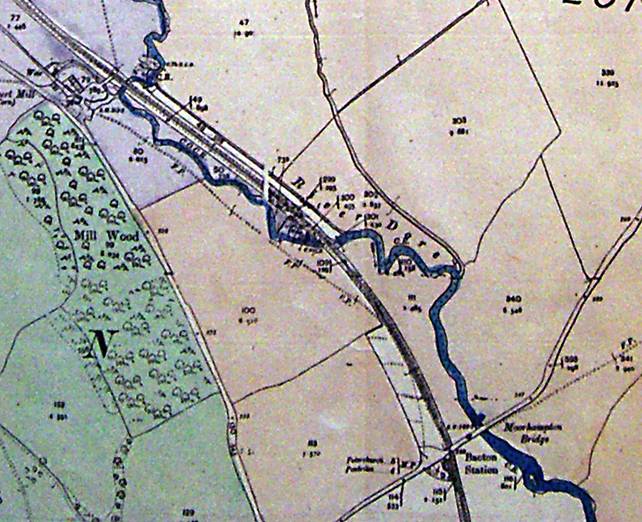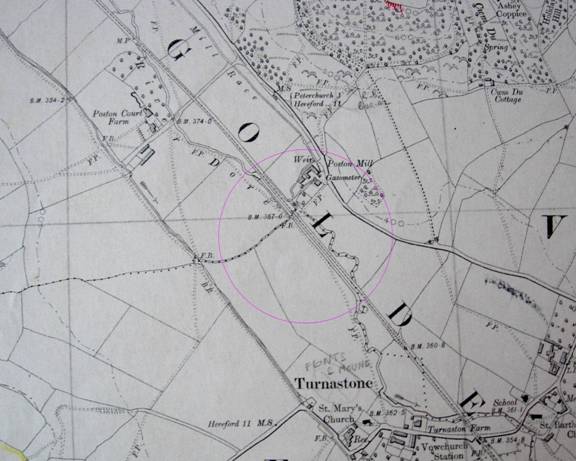Title: | Elizabeth Pugh versus the Golden Valley Railway Company |
Date: | 1876-1886 |
Elizabeth Pugh versus the Golden Valley Railway Company
The Golden Valley Railway Company became notorious for its failure to generate returns for its investors. It never made a profit, no dividends were paid on its shares, and eventually shareholders lost nearly all their capital when the Company went bankrupt in 1899. Many ordinary local people as well as wealthy landowners in the Golden Valley suffered serious financial hardship as a result. One exception to this was Elizabeth Pugh of Bridge Farm, Ewyas Harold. She was not so far as we know a shareholder in the railway, but through the sale of a few acres of her land for the track she eventually managed something that other local people singularly failed to achieve – with the help of the Law Courts she made money from the railway. This is the story of how it happened.
The section of the Golden Valley Railway from Pontrilas to Dorstone, authorised by Act of Parliament in 1876, was constructed between 1876 and 1879 by railway contractors. The line broadly followed the valley of the river Dore, described as a ‘very sinuous stream’’. Because of its twists and turns, the railway had to cross the river in numerous places.
In one such place between the 1 mile and 1¼ mile posts [from Pontrilas] at Bridge Farm in the parish of Ewyas Harold the river Dore crossed the projected route of the railway from east to west and after flowing southward for about ¼ of a mile crossed the line again, this time from west to east, The original intention seems [from the maps of land purchased and from deposited plans relating to the original enabling Act] to have been to build two bridges to take the railway across the river at these points. However, the contractor instead used an approach seen in a number of other places on the line and dug a trench, or ‘goit’ along the eastern side of the line. This served several important purposes. It provided spoil for the railway embankment that would otherwise have had to be found, transported and paid for elsewhere. At the same time it allowed the river to be diverted alongside the track through the trench thus removing the need for two expensive bridges. This in turn reduced the construction cost and increased the profit of the contractor.
In this instance the contractor inserted a single twelve inch diameter pipe under the railway embankment at one end and a cutting with an under-bridge at the other in an attempt to feed river water into the section of the natural riverbed cut off by the diversion, but in the event this did not produce sufficient flow of water to prevent that section of the river turning into an overgrown, stagnant pool..
Miss Elizabeth Pugh owned the section of the river affected and the adjacent land, which had not been included in the original parcel she had sold to the Golden Valley Railway Company for their track. She considered that her “riparian rights” [the legal rights of landowners whose property adjoins a body of water to make reasonable use of it] over the watercourse had been infringed by the Railway Company’s actions. After apparently protracted attempts to negotiate a settlement the matter was taken to Court where she won an injunction against the Golden Valley Railway Company to ‘restrain the defendant company from continuing to obstruct the natural flow of the stream’. The Company then took the case to appeal, probably with the moral and perhaps financial support of bigger railway companies who believed the law entitled them to take such actions in the construction of their lines and had a strong interest in preserving those assumed freedoms.
The Court of Appeal was held over three days at the end of May and beginning of June in 1880 before three judges and the proceedings were reported in the Law Times of 21 August 1880 . The barristers acting for the Golden Valley Railway Company did not apparently dispute that there had been a loss of riparian rights by Miss Pugh but argued that the railway company was allowed by the Act of Parliament to divert any road or water course in the execution of their works as they saw fit. However, the judges found in favour of Miss Pugh, with costs, and said in their written judgement that whilst the Act of Parliament allowed companies to divert roads and natural water courses where this was a necessity, it was not permissible in law to do so merely for convenience or to save expense.
The case established a significant point of law in regard to railway construction work done under Acts of Parliament and thus became a legal landmark and precedent.
The location of Miss Pugh’s land and the disputed diversion of the river are shown on the map below, circled in red, and lies at the boundary between Bridge Farm and Lower House Farm, the latter then part of the Abbeydore Court Estate of Thomas Freke-Lewis. Following the Appeal Court judgement and subsequent negotiations the affected pieces of Miss Pugh’s land were purchased by the Golden Valley Railway Company six years later in 1886. The conveyance and a map are contained in an Abstract of the Title of the British Transport Commission [1960] in our Digital Archive.

Diversion of the River Dore by the Golden Valley Railway at Bridge Farm, Ewyas Harold
It is interesting to note that the contractors used similar goits to divert the river in several other places on the line. It is reasonable to assume this was a widespread practice in the railway construction business, where the easiest gradients in hilly country would often be found along river valleys but meandering watercourses would also tend to cause problems. Indeed, from the perspective of a cost-conscious railway contractor the approach would certainly have seemed a common-sense way to improve the profitability of his work. A further example on the Golden Valley line can be seen on the map below near Poston Mill, just north of Turnastone,
|
|
| Extract from the 6 inch OS map of 1905 |
|
|
|
|
And the same approach can be seen again further south near Bacton Station

Extract from a map of the Bacton Estate, part of the 1919 Sale Particulars
It is not known if any legal or other action against the railway company were brought in any of these other cases, but since most of the landowners were shareholders in the railway it would probably not have been in their interests to do so. However, the settlement of the action brought by Elizabeth Pugh alone was an expensive affair. The details of the negotiations can only be surmised, but the end result in 1886 was that the railway company paid £300 to Miss Pugh to purchase the small patches of land cut off by the diversion of the river and to compensate her for “all damage sustained or to be sustained” in connection with the affair. This amounted to nearly £170 per acre, well over twice the ‘going rate’ of about £70 per acre paid when the Company originally bought land for the railway. The settlement was even more punitive in the context that much of the original land obtained by the Railway Company, and even the construction of the line itself, was paid for in shares rather than cash, which was always in short supply. Bearing in mind Miss Pugh’s legal costs were also awarded against the Company as well as their own, it would no doubt have been considerably cheaper to build the two planned bridges in the first place.
Given the sorry financial history of the Golden Valley Railway Company , it seems possible that Elizabeth Pugh was the only person to actually make a profit from the Company’s activities over the years of its existence. Except for the lawyers, of course.
Ref: rs_gdv_0052

